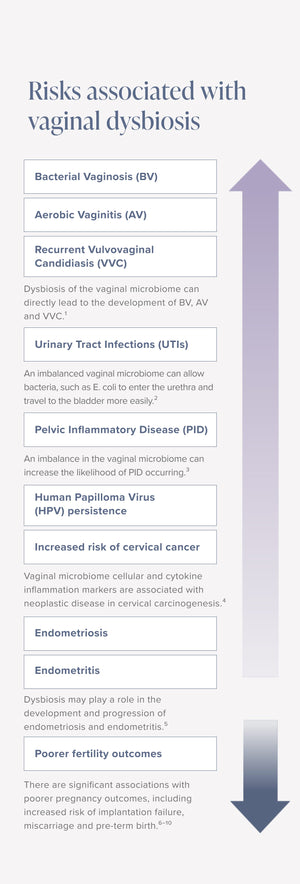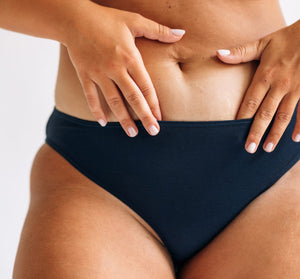
When in balance
The vaginal microbiome is dominated by lactic acid producing bacteria, most commonly Lactobacillus species, which keep the environment acidic and free from potentially problematic bacteria.

When in dysbiosis
Dysbiosis of the vaginal microbiome refers to an imbalance in the natural bacterial community. Specifically, a disruption to the normal dominance of beneficial bacteria lactobacilli, where a highly diverse state of opportunistic anaerobic and aerobic microbes takes hold instead.
Dysbiosis can arise from several factors, including:
- Shifts in vaginal pH (lifestyle factors)
- Microbe transmission (between partners)
- Use of medications (antibiotics and contraceptives)
It is especially common when oestrogen levels decrease during:
- Postnatal period
- Menopause
- Certain cancer treatments
Oestrogen depletion contributes to vaginal dysbiosis by:
- Increasing vaginal pH
- Reducing the presence of Lactobacillus
- Promoting the colonisation of opportunistic and potentially pathogenic microbes



Urogenital health conditions are prevalent and significantly impact quality of life:
- 75% of women will experience Vulvovaginal Candidiasis (VVC) at least once in their lifetime.¹¹
- 6% of women will suffer from recurrent episodes of VVC (thrush).¹¹
- 29% of reproductive age women are affected by Bacterial Vaginosis (BV).¹²
- The prevalence of Aerobic Vaginitis (AV) ranges between 7-12% in women.¹³
- 50% of women will experience an acute Urinary Tract Infection (UTI) in their lifetime.¹⁴
- 3,300 new cases of cervical cancer are diagnosed each year.¹⁵
- 69% of women do not achieve pregnancy through IVF treatment.¹⁶
- 10% of women with Pelvic Inflammatory Disease (PID) become infertile.¹⁷

Vaginal lactobacillus
Lactobacillus benefits include:
- the production of lactic acid, which helps to maintain a healthy vaginal pH
- the release of bacteriocins, which provide antimicrobial activity
- adherence to cell walls, which form a protective barrier against pathogens
Vaginal Lactobacillus contribute to the maintenance of an acidic pH, produce antimicrobial compounds and modulate the host immune response to protect against vaginal bacterial and fungal infections.

Vaginal probiotics
Our vaginal probiotics contain four strains of Lactobacillus naturally found in a healthy vagina:
- Lactobacillus crispatus, LBV 88
- Lactobacillus rhamnosus, LBV 96
- Lactobacillus gasseri, LBV 150N
- Lactobacillus jensenii, LBV 116
These strains are proven to reach the vaginal canal alive to rebalance the vaginal microbiome naturally.

Microbiome screening
Our Vaginal Microbiome Test is beneficial for anyone:
- with unexplained symptoms such as itching, burning or pain
- with chronic vaginal infections seeking targeted treatment
- struggling to conceive, given the link between pathogens and pregnancy outcomes
- with UTIs wanting to discover if pathogenic microbes are a factor
- looking to assess their microbiome for links to HPV persistence, cervical cancer risk or endometriosis progression
Our test uses a highly parallelised quantitative PCR based approach reporting a presence of 50+ species, with microbial load quantification and easy to interpret results for healthcare providers.
REFERENCES: 1. Machado A, et al. 2022 Aug 9;12:976057. 2. News-Medical.net. What Role Do Microbiomes Play in Urinary Tract Infections? Available at: https://www.news-medical.net/health/What-Role-do-Microbiomes-Play-in-Urinary-Tract-Infections.aspx 3. van de Wijgert JHHM, Jespers V. Res Microbiol. 2017 Nov-Dec;168(9-10):859-864. 4. Ntuli L, et al. Front Cell Infect Microbiol. 2022;12:927131. 5. Zizolfi B, et al. 2023;14:1140774. 6. Hong X, et al. BMC Med. 2022;20(1):246. 7. Ricci S, et al. PLoS One. 2018 Nov 16;13(11):e0207684. 8. Mendz GL. Applied Microbiology. 2023; 3(4):1302-1338. 9. Cutoiu A, Boda D. Biomed Rep. 2024 Jun17;21(2):119. 10. Group B Strep Support. Available at https://gbss.org.uk/professional-resources/gbs-incidence/ 11. NICE. Available at: https://cks.nice.org.uk/topics/candida-female-genital/background-information/prevalence/ 12. Koumans EH, et al. Sex Transm Dis. 2007;34(11):864-869. 13. Donders GGG, et al. Res Microbiol. 2017;168(9-10):845-858. 14. Patient.info. Available at: https://patient.info/doctor/urinary-tract-infection-in-adults# 15. Cancer Research UK. Available at: https://www.cancerresearchuk.org/health-professional/cancer-statistics/statistics-by-cancer-type/cervical-cancer 16. IVF London. Available at: https://ivflondon.co.uk/success-rates/ 17. ACOG. Available at: https://www.acog.org/womens-health/faqs/pelvic-inflammatory-disease 18. Avitabile E, et al. Int J Mol Sci. 2024;25(17):9168.


